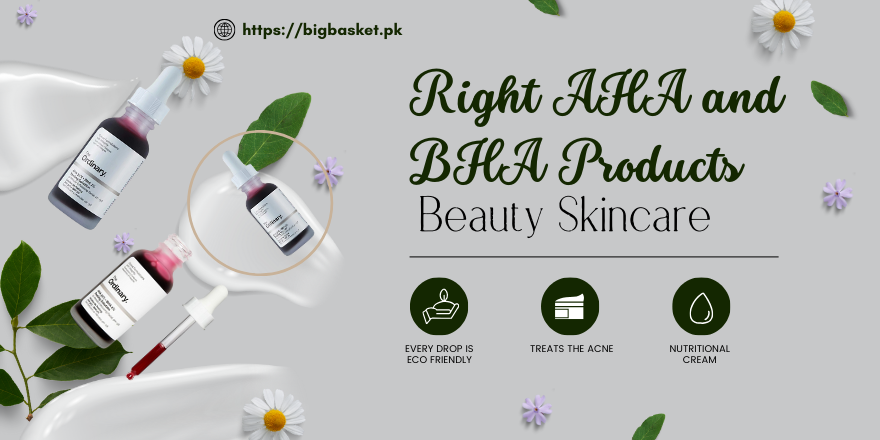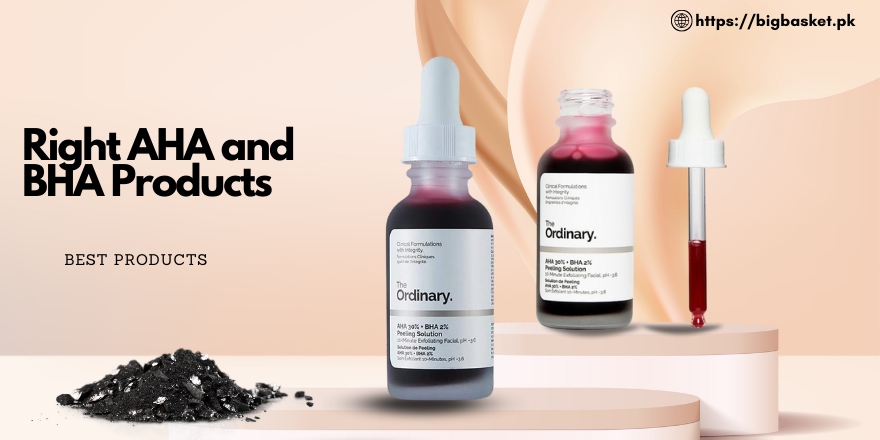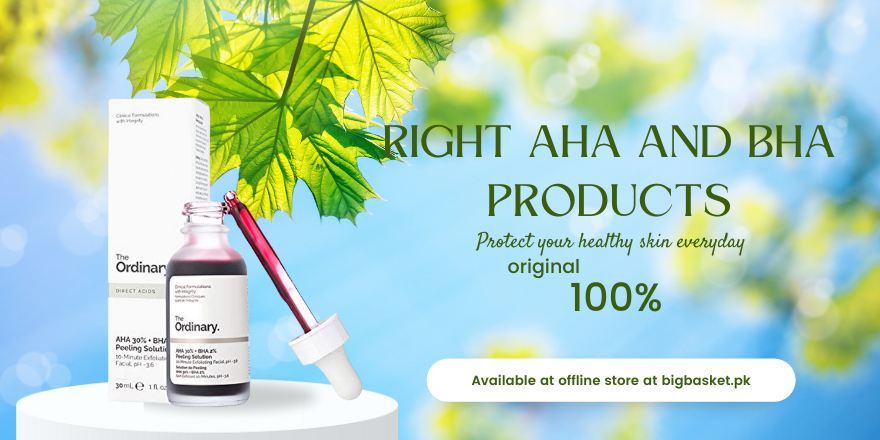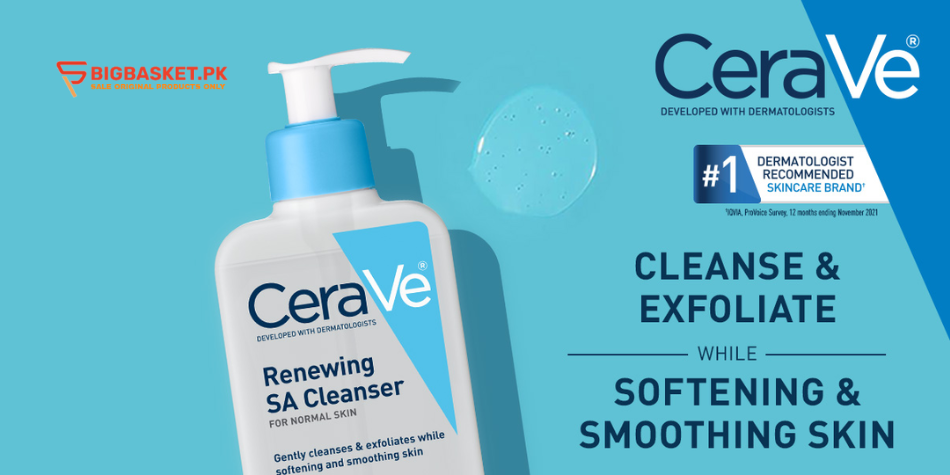Right AHA and BHA Products

Understanding your skin type is crucial when it comes to choosing the right AHA and BHA products for your skincare routine. By identifying your skin type, you can tailor your product selection to address specific concerns and achieve optimal results. There are commonly recognized skin types: oily, dry, combination, and sensitive.
Oily skin tends to produce excess sebum, leading to a shiny complexion and a higher propensity for acne breakouts. Dry skin, on the other hand, lacks moisture and may appear flaky or rough. Combination skin exhibits characteristics of both oily and dry skin, with oiliness in the T-zone and drier areas on the cheeks.
Lastly, sensitive skin is prone to irritation and may react adversely to certain ingredients. By knowing your skin type, you can make informed decisions about the AHA and BHA products that will work best for you, addressing your specific concerns and promoting a healthier complexion.
Choose AHA or BHA
When choosing between AHA (Alpha Hydroxy Acid) and BHA (Beta Hydroxy Acid) products for your skincare routine, it’s important to consider their unique properties and how they can benefit your skin type. AHA, such as glycolic acid and lactic acid, is known for its ability to exfoliate the skin’s surface, promoting cell turnover and revealing a smoother, brighter complexion.
It is particularly effective for those with dry or sun-damaged skin. On the other hand, BHA, commonly in the form of salicylic acid, penetrates deeper into the pores, making it ideal for oily or acne-prone skin types. BHA helps to unclog pores, reduce inflammation, and improve overall skin texture.
It’s important to note that both AHA and BHA can be beneficial for combination skin, as their specific properties can target different areas of concern. Ultimately, choosing the right AHA or BHA product depends on your skin type and specific needs, so it’s advisable to consult with a skincare professional or dermatologist to determine the best option for you.
Consult with a dermatologist
Seeking guidance from a dermatologist can be immensely helpful when it comes to choosing the right AHA and BHA products for your skin type. Dermatologists are highly trained experts who can assess your skin’s specific needs and recommend the most suitable products that will address your concerns effectively.

They can provide personalized advice based on your skin type, sensitivity, and any existing skin conditions you may have. Additionally, dermatologists can offer valuable insights into the correct usage and frequency of AHA and BHA products, ensuring that you achieve optimal results while minimizing the risk of irritation or adverse reactions.
By consulting with a dermatologist, you can make informed decisions about your skincare routine and feel confident in the choices you make for your skin’s health and well-being.
AHA and BHA: Understanding the Differences
Alpha hydroxy acids (AHAs) and beta hydroxy acids (BHAs) are popular ingredients in skincare products, known for their ability to exfoliate the skin and improve its texture and appearance. While both AHAs and BHAs offer similar benefits, it is important to understand their differences to determine which one is best suited for your skin type and concerns.
AHAs, such as glycolic acid and lactic acid, are water-soluble and primarily work on the surface of the skin to remove dead skin cells, revealing a smoother complexion. BHAs, on the other hand, like salicylic acid, are oil-soluble and can penetrate deeper into the pores, making them particularly effective for treating acne-prone and oily skin. Understanding the distinctions between AHAs and BHAs can help you choose the right product to target your specific skincare needs.
Popular AHA and BHA Products
When it comes to popular AHA and BHA products, there is a wide range of options available in the market to cater to different skincare needs. One highly regarded AHA product is the glycolic acid toner, which is known for its ability to gently exfoliate the skin and promote a more even skin tone. Another popular choice is the lactic acid serum, which not only exfoliates but also helps to hydrate and brighten the skin.
Moving on to BHA products, the salicylic acid cleanser is a go-to option for those with oily and acne-prone skin, as it effectively unclogs pores and reduces breakouts. Additionally, there are BHA spot treatments and serums that specifically target blemishes and help alleviate inflammation.
These popular AHA and BHA products have gained recognition for their effectiveness in addressing specific skin concerns, providing individuals with a variety of options to choose from based on their unique needs and preferences.
incorporating AHA and BHA into Your Skincare Routine
To effectively incorporate AHA and BHA products into your skincare routine, it is important to start slowly and gradually introducing these active ingredients. Begin by using them once or twice a week and then gradually increase the frequency as your skin becomes accustomed to them. It is also crucial to patch-test any new product before applying it to your entire face to check for any adverse reactions.
When incorporating AHA products, such as glycolic acid or lactic acid, into your routine, it is best to use them in the evening after cleansing and toning. Follow up with a moisturizer to maximize hydration and minimize any potential dryness or irritation. As for BHA products, like salicylic acid, they can be used in both morning and evening routines, especially if you have oily or acne-prone skin.
However, it is important to incorporate sunscreen during the day as these products can make your skin more sensitive to the sun. By gradually incorporating AHA and BHA products into your skincare routine and taking into consideration your skin type and specific needs, you can effectively harness the benefits of these active ingredients for a healthier, glowing complexion.
Skincare: Tailoring to needs.
When it comes to skincare, tailoring your routine to meet your specific needs is crucial for achieving optimal results. Understanding your skin type is the first step in determining which products will work best for you.
Dry or dull skin may benefit from the exfoliating properties of AHA (Alpha Hydroxy Acid) products, such as glycolic acid and lactic acid, which help to remove dead skin cells and reveal a more radiant complexion.
On the other hand, if you have oily or acne-prone skin, BHA (Beta Hydroxy Acid) products, like salicylic acid, can effectively penetrate the pores and unclog them while reducing inflammation. By identifying your skin type and concerns, you can select the appropriate AHA or BHA products that will specifically address your needs and deliver the desired outcomes for your skin.
Know your skin: Identifying skin type.
Understanding your skin type is crucial when it comes to choosing the right skincare products, especially those containing AHA and BHA ingredients. By identifying your skin type, you can tailor your skincare routine to address specific concerns and achieve optimal results. There are five common skin types: normal, dry, oily, combination, and sensitive.
Normal skin is well-balanced, with few concerns, while dry skin tends to be flaky and lacks moisture. Oily skin is characterized by excess sebum production, often leading to shine and potential breakouts. Combination skin exhibits both oily and dry areas, typically with an oily T-zone and drier cheeks.
Lastly, sensitive skin is prone to irritation and may react adversely to certain ingredients. Determining your skin type will guide you in selecting the appropriate AHA and BHA products that cater to your specific needs, helping you achieve healthier and more radiant skin.
AHA vs. BHA: Choosing wisely.
When it comes to choosing between AHA (Alpha Hydroxy Acid) and BHA (Beta Hydroxy Acid) products, it is essential to consider their unique properties and how they align with your skin type and concerns. AHA, such as glycolic acid and lactic acid, works by exfoliating the skin’s surface, effectively removing dead skin cells and promoting cell turnover.
This makes AHAs particularly beneficial for those with dry or dull skin, as it helps to reveal a smoother, more radiant complexion. On the other hand, BHA, mainly salicylic acid, is oil-soluble, allowing it to penetrate the pores deeply. This makes BHA ideal for individuals with oily or acne-prone skin, as it can effectively unclog pores and reduce inflammation. Ultimately, choosing between AHA and BHA products depends on your specific skin type and concerns, ensuring that you select the right ingredient that will address your needs and provide the best results for your skin.
Synergistic effects when combining AHA/BHA.
When it comes to skincare routines, the combination of AHA (alpha hydroxy acid) and BHA (beta hydroxy acid) products can offer synergistic effects that can greatly benefit the skin. AHA, such as glycolic acid, works by exfoliating the surface of the skin, removing dead skin cells, and promoting cell turnover. On the other hand, BHA, like salicylic acid, can penetrate the pores and exfoliate deep within, effectively removing excess oil and preventing breakouts.

When used together, these two acids can work harmoniously to address multiple skincare concerns, such as acne, blackheads, dullness, and uneven texture. The exfoliating properties of AHA and BHA can complement each other, leading to smoother, clearer, and more radiant skin. However, it is important to note that because these acids can be potent, it is crucial to introduce them gradually into your skincare routine and to always use them in conjunction with a broad-spectrum sunscreen to protect the skin from potential sensitivity and sun damage.
Understanding the differences between AHA/BHA.
AHA and BHA are both types of chemical exfoliants commonly used in skincare products, but they differ in their composition and how they work on the skin. AHA, or alpha hydroxy acid, is water-soluble and primarily works on the surface layer of the skin. It is effective in removing dead skin cells, improving skin texture, and promoting a brighter complexion. On the other hand, BHA, or beta hydroxy acid, is oil-soluble and can penetrate the pores deeply.
It is particularly beneficial for those with oily or acne-prone skin as it can effectively unclog pores, reduce inflammation, and prevent breakouts. Understanding the differences between AHA and BHA is important when selecting products for your skincare routine, as their unique properties can target specific skin concerns. It is advisable to consult with a dermatologist or skincare professional to determine which acid is best suited for your individual needs and to ensure proper usage and potential interactions with other skincare products.
Incorporating AHA/BHA into daily skincare.
When incorporating AHA and BHA products into a daily skincare routine, it is crucial to consider a few important factors. Firstly, starting with a lower concentration of these acids is recommended and gradually increasing it over time to allow the skin to adjust. Additionally, it is important to follow the instructions provided by the product manufacturer and not exceed the recommended usage frequency.
AHA and BHA products are known to increase the skin’s sensitivity to the sun, so it is essential to apply a broad-spectrum sunscreen with a high SPF during the day to protect the skin. It is also advisable to introduce AHA and BHA products gradually into your routine, using them on alternating days or a few times a week to prevent over-exfoliation and irritation. Lastly, it is essential to pay attention to how your skin reacts to these acids and adjust your routine accordingly, seeking professional advice if necessary.
Understand potential side effects.
It is crucial to have a thorough understanding of the potential side effects associated with the use of AHA and BHA products. While these ingredients can offer significant benefits for the skin, they can also lead to adverse reactions in certain individuals. Some common side effects include skin irritation, redness, dryness, and peeling.
These reactions are typically mild and temporary, but it is important to monitor your skin’s response and discontinue use if any severe or persistent side effects occur. Additionally, individuals with sensitive skin or certain skin conditions may be more prone to experiencing negative reactions. It is recommended to perform a patch test before incorporating AHA and BHA products into your skincare routine and to consult with a dermatologist if you have any concerns or experience any side effects.
Properly use AHA and BHA.
When using AHA and BHA products, it is essential to follow proper guidelines to ensure maximum effectiveness and minimize the risk of adverse reactions. Start by introducing these products gradually into your skincare routine, especially if you have never used them before. Begin with a lower concentration and frequency of application, allowing your skin to acclimate to the ingredients.
As your skin becomes more tolerant, you can gradually increase the concentration and frequency, but always be mindful of your skin’s reaction. It is also important to use sunscreen daily, as AHA and BHA products can increase skin sensitivity to the sun. Apply these products to clean, dry skin and allow them to absorb fully before layering other skincare products.
Lastly, be sure to follow the instructions provided by the manufacturer and avoid combining AHA and BHA products with other exfoliating ingredients to prevent over-exfoliation and potential irritation. By properly using AHA and BHA products, you can reap their benefits while minimizing the risk of adverse effects.
Monitor skin for any reactions.
To ensure the safe use of AHA and BHA products, it is crucial to monitor your skin for any reactions. After applying these products, observe your skin for any signs of irritation, redness, itching, or burning sensations. If you experience any of these reactions, discontinue use immediately and consult with a dermatologist. Additionally, watch for any excessive dryness or flaking, as this may indicate that the product is too harsh for your skin.
Remember, everyone’s skin is unique, and what works for others may not necessarily work for you. By closely monitoring your skin’s response, you can make informed decisions about the continued use of AHA and BHA products and adjust your skincare routine accordingly.
while AHA and BHA products offer numerous benefits for the skin, it is important to be aware of the potential side effects that may occur. It is always recommended to patch-test new products and introduce them slowly into your skincare routine. If you experience any adverse reactions, it is best to discontinue use and consult with a dermatologist. With proper usage and caution, AHA and BHA products can effectively improve the overall health and appearance of your skin.
Target skin concerns with AHA/BHA.
When it comes to addressing specific skin concerns, such as acne, hyperpigmentation, or dullness, AHA (alpha hydroxy acid) and BHA (beta hydroxy acid) products can be highly effective. AHA products, such as glycolic acid, are known for their exfoliating properties and can help to remove dead skin cells, promoting a brighter and smoother complexion. On the other hand, BHA products, such as salicylic acid, are oil-soluble and can penetrate deeper into the pores, making them ideal for treating acne and controlling excess oil production.
Additionally, both AHA and BHA can help to improve the appearance of fine lines and wrinkles, as well as enhance overall skin texture. When considering AHA and BHA products for specific skin concerns, it is important to look for specific ingredients that target those concerns, such as hyaluronic acid for hydration or niacinamide for reducing redness and inflammation. By incorporating AHA and BHA products into your skincare routine, tailored to your specific skin concerns, you can achieve a more radiant and healthier complexion.
Ingredients for radiant, clear skin.
To achieve radiant, clear skin, there are key ingredients that you should look for in skincare products. Vitamin C is a powerful antioxidant that can help brighten the complexion and fade dark spots caused by sun damage or hyperpigmentation. It also aids in collagen production, promoting firmer and smoother skin. Another beneficial ingredient is niacinamide, which helps to regulate oil production, minimize pores, and reduce redness and inflammation.

Hyaluronic acid is essential for hydration, as it attracts and retains moisture in the skin, resulting in a plump and hydrated appearance. Additionally, ingredients like retinol or retinoids can help improve skin texture, reduce the appearance of fine lines and wrinkles, and promote cellular turnover. When selecting products for radiant, clear skin, be sure to look for these ingredients and consider your specific skin concerns to find the most suitable options for your skincare routine.
Customize routine for optimal results.
When it comes to achieving optimal results for your skin concerns, it is important to customize your skincare routine. Every individual has unique skin needs, and a personalized approach can address specific concerns more effectively. Consider factors such as your skin type, concerns (such as acne, aging, or sensitivity), and any specific goals you have for your skin. For example, if you are dealing with acne-prone skin, incorporating products with salicylic acid or benzoyl peroxide can help target breakouts and control sebum production.
On the other hand, if you are concerned about aging, including products with ingredients like peptides and antioxidants can help improve firmness and reduce the appearance of wrinkles. By tailoring your skincare routine to your specific needs, you can optimize the results and achieve healthier, more radiant skin.
FAQ’s
What are AHA and BHA products?
AHA (Alpha Hydroxy Acid) products: These contain acids like glycolic, lactic, or citric acid to exfoliate the skin, revealing a smoother complexion and improving skin texture.
BHA (Beta Hydroxy Acid) products: These include salicylic acid, which penetrates pores to unclog them, making them ideal for acne-prone skin and managing oiliness.
How do I choose between AHA and BHA products?
For smoother texture: Opt for AHA products to exfoliate and brighten your skin.
For acne-prone or oily skin: Consider BHA products, especially those containing salicylic acid, to clear pores and prevent breakouts.
What should I look for in AHA and BHA products?
Concentration: Start with lower concentrations to avoid irritation, especially if you’re new to these acids.
pH Level: Look for products with an appropriate pH level to ensure effectiveness without causing harm to the skin barrier.
Additional Ingredients: Some products may contain soothing agents like aloe vera or hydrating elements like hyaluronic acid, which can complement the effects of AHA or BHA.
How often should I use AHA and BHA products?
Start Slowly: Begin using these products a few times a week and gradually increase frequency as your skin gets accustomed.
Listen to Your Skin: If you notice any irritation or dryness, reduce the frequency of use.
Can I use AHA and BHA products together?
It’s possible to combine them, but it’s advisable to start with separate usage to understand how your skin reacts to each acid before considering a combined approach.
Consider Alternating: If combining, alternate days or use them in different parts of your routine to minimize potential irritation.
Is sunscreen necessary when using AHA or BHA products?
Yes, sunscreen is crucial. Both AHAs and BHAs can increase sun sensitivity, so applying sunscreen daily is essential to protect your skin from UV damage.
Should I consult a professional before using AHA or BHA products?
If you have sensitive skin or specific skin conditions, it’s wise to consult a dermatologist before incorporating these acids into your routine.
Patch Test: Always perform a patch test before using any new product to check for adverse reactions.
No products found









